Pothos, or Epipremnum aureum, are a family of tropical perennials with distinctive heart-shaped leaves that grow in long, tangling vines. All over the world, they are well-loved as houseplants, primarily because of their extremely hardy natures, which are suited to a range of living conditions.
If you’re already in the know about the joys of owning a pothos, you may also be aware of the fact that not only are they prolific growers, but propagating pothos is an incredibly easy process. And if you didn’t know that, then this is going to be excellent news for anyone looking to expand their pothos collection!
That said, if you have questions about whether water or soil propagation is better or how to make a stem cutting from an existing plant, you’ve come to the right place. In this article, I’ll take you through everything there is to know about propagating a pothos. Ready? Let’s get right to it.
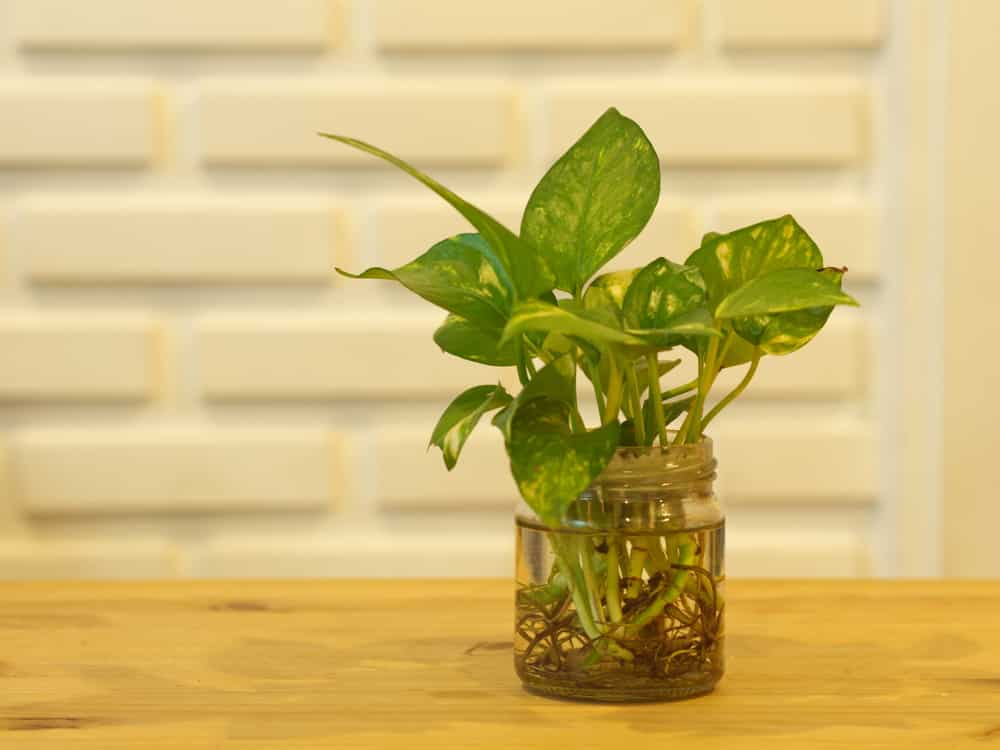
Table of Contents
How to propagate pothos
The best way to propagate a pothos plant is to first root a stem cutting in water and then transfer it into a planter with prepared soil. Pothos cuttings can also be rooted directly into soil, provided they have access to plenty of moisture and humidity.
Identifying a stem cutting with visible nodes and, if possible, two to three leaves gives you your best chance of success.
Most pothos enthusiasts just can’t get enough of these gorgeous plants, making their tendency to propagate successfully very endearing. Indeed, the propagation process is also incredibly straightforward, which is good news for those who may be a little nervous about snipping off sections of their beloved plants.
Let’s look at how to propagate a brand new pothos juvenile in greater detail.
1. Prepare your workstation
Before propagating any plant, it’s always good to ensure you have a clean and spacious workspace available. This mitigates the risk of contagious bacteria or fungi that spread between plants and makes it easier overall for you to wrangle your cuttings and get them ready for rooting.
Ideally, you want a table or countertop free of any clutter. Depending on whether you are rooting in water or directly into soil, you should also prepare your jar or planter in advance to minimize your pothos’ cut’s exposure to air (which can dry it out).
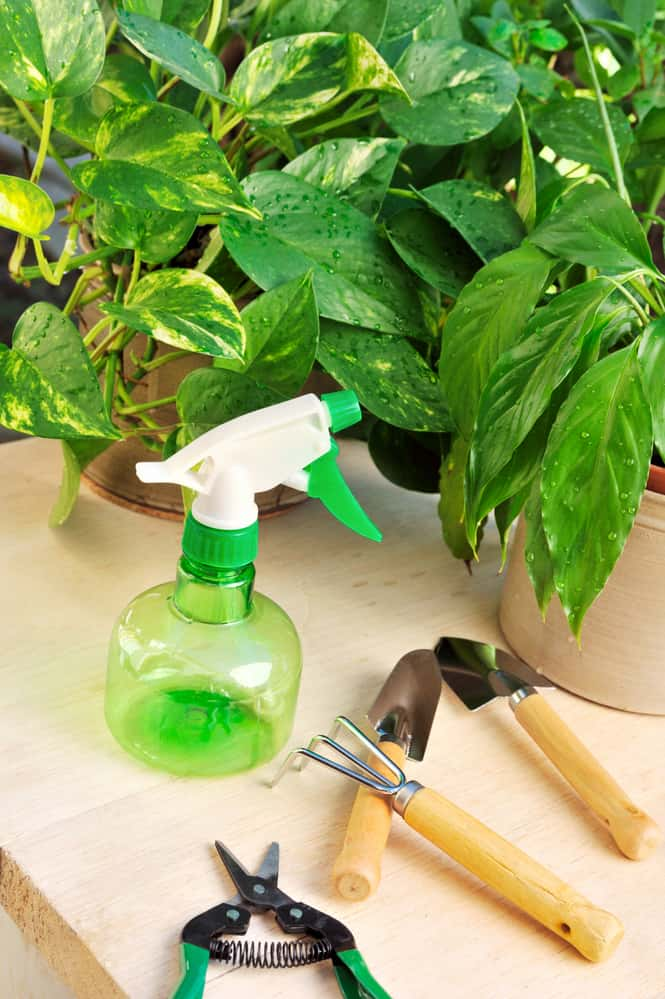
2. Clean and sterilize your tools
Finally, make sure your cutting tools are sharp and sterilized. This will give you the cleanest snip possible and prevent any pesky bugs or diseases from infecting your new plant.
3. Select your cutting
The size, quality, and health of your cutting will have an enormous bearing on how well it propagates. Robust plants are full of energy and have the potential to root quickly and easily.
An ideal stem cutting has two to three visible root nodes (from which new growth will develop) and two to three leaves that can draw in moisture and oxygen from the air.
In terms of length, I recommend selecting a stem that is 5 to 7 inches long (12 to 20 centimeters). Shorter cuttings can work too, but their success rate is slightly lower, and they may require additional care measures, like supplemental humidity.
Related: 7 Proven Steps to Root a Pothos Cutting
4. Prune your cutting
Once you have identified your cutting, the next step is to cleanly remove it from the parent plant by pruning your pothos with a sharp, diagonal snip.
We’ll get into more detail shortly about where on your pothos to take your cutting from.
5. Consider using rooting hormone
While there are no hard or fast rules about using a rooting hormone to propagate pothos, it is beneficial because it gives your plant an extra boost of nutrients before developing new growth.
Application is simple. Before placing your cutting into water or soil, all you need to do is dip the cut end into rooting powder – and the rest, as they say, is history.
6. Place your cutting into its growing medium
With your cutting selected and your growing medium at the ready, all that’s left to do is set it in place to root.
In the case of water propagation, this means inserting your stem into (preferably filtered) water and placing it in a warm, sunny spot where it will receive the light your pothos needs for 6 to 8 hours each day. The water should be replaced weekly to ensure it remains oxygenated.
FYI: Rooting into prepared soil requires a little more admin, as the ground you use should tick certain boxes. I always opt for the best soil for pothos which is a high-quality potting soil mixed with marginal amounts of perlite and orchid bark to know my cuttings are rooting in well-aerated soil rich in nutrients.
7. Move your cutting to a warm, humid area in your home
Once planted, soil-rooting cuttings should also be situated in warm, humid areas of your home. In addition to this, it’s advisable to mist your cutting’s leaves every few days, as the plant is still in the process of developing the roots it needs to draw moisture from its soil.
You may also be interested in: Do Pothos Like Humidity? (6 Tips to Boost It)
8. Care for your cutting
After placing your cutting into its growing medium, all that’s left to do is practice consistent care until such a time that it roots. This requires adequate humidity from the sun and consistent hydration.
In other words, if you notice the pothos is drooping, wilting, or stagnating, you may need to consider which of its needs are unmet and adjust your care practices accordingly.
Where to cut pothos to propagate it
Stem cuttings should be taken from just below a leaf node at a diagonal, 45-degree angle. Each cutting should have 2 to 3 visible nodes, and you should strip off the lower leaves so that none are submerged in water or soil.
How and where you cut your stem for propagation will impact how well it takes to new growth. Unfortunately, this means that selecting and snipping your cuttings is undoubtedly the most daunting part of propagation.
For one, you don’t want to hurt your plant, and secondly, you want to find a branch that has a good chance of rooting. You already know it should be reasonably lengthy (5 to 7 inches/12 to 20 centimeters) with a few leaves and nodes. That said, cuttings should not be taken at the cost of your parent plant and never more than 30% of its total spread.
Together with this, you also want to cut from the ends of vines that have some growth to spare. New, strong leaves are preferable to older or aging ones, which are functioning at a bit of an energy deficit. Conversely, freshly budding leaves are not ideal either, as they may suffer transplant shock during this more delicate growing phase.
An ideal cutting is from an established vine with fresh but mature leaves. The stem itself should be thick and strong, with bold nodes that you can cut just beneath.
Find out more about: 12 Reasons Why Your Pothos Is Not Growing (and How to Fix It)
Is it better to propagate pothos in soil or water?
The best way to propagate pothos stem cuttings is to root them first in water before transferring them into planters with nutrient-rich soil. In water, nodes have consistent access to hydration, making it easier for them to develop into new roots.
This is in comparison to soil-rooting, where they rely heavily on moisture from the air and therefore require higher humidity levels.

I’m generally of the opinion that it’s each to their own when it comes to propagation, as some prefer rooting in soil and others prefer rooting in water. However, science backs the idea that stem cuttings have a better chance of rooting with ongoing access to hydration, as is the case with water propagation.
When you first cut your stems, they have no roots and therefore rely entirely on the moisture they receive via their leaves and nodes. While damp soil is adequate, your cutting’s access to hydration is less direct than in a jar full of water. More moisture equals faster growth, provided it remains oxygenated, which is why you need to replace your water weekly.
You may also be interested in:
- 5 Easy Steps to Transfer a Propagated Pothos from Water to Soil
- 6 Simple Steps to Grow Pothos in Water Successfully
Can you put pothos cuttings directly into soil?
Plants in the pothos family are a hardy bunch and can be propagated directly into soil if you have a healthy cutting with several nodes and leaves. In this regard, leaves are pretty crucial, as they form the main passage for moisture to enter the stem, providing it with energy to develop new growth.
Heat and humidity are equally important, preferably directly from the sun or from supplementary devices like plug-in humidifiers, misting, grow lamps, or damp pebble trays. This will give your cutting an extra kick of energy while it adjusts and develops roots.
The final and perhaps most important aspect of soil propagation is providing your cutting with good-quality ground. It should be aroid and nutrient-rich but without being heavy and constricting. Perlite and orchid bark mixes are best, as this allows room for air circulation while simultaneously retaining dampness.
How long does it take for pothos cuttings to root?
Most pothos are medium to fast-growing and can root in water in as little as four to six weeks. This is, of course, also dependent on their growing environments. They require plenty of light, humidity, and oxygen to take root and will slow their growth pace if these needs are not met.
In a hurry to expand your pothos collection? You’re in luck. These beauties root quickly in ideal growing environments and will start to develop tiny new roots in just a few days.
By the four to six-week mark, new growth should be in the region of 1 to 2 inches (2 to 5 centimeters), at which stage your pothos is just about ready to be transplanted into soil.
Related: 14 Proven Tips to Make a Pothos Fuller and Bushier
Propagation directly into soil can take a bit longer, as your nodes have slightly less access to hydration. However, it’s also well-nigh impossible to monitor unless you plan to dislodge your cutting from its soil, which I would not advise.
In these cases, so long as your new pothos is happy and healthy, the chances are high that it’s rooting just fine and will develop fresh leaves and stems in due course.
How often should I water pothos when propagating it?
The moisture requirements for established pothos and actively rooting pothos are the same. Both require regular watering (every 7 to 10 days), with time for the soil to dry out slightly in between. That said, rooting cuttings can benefit from the additional measure of leaf misting every 2 to 3 days.
When growing new plants, the temptation to over-love them can be very real, especially when it comes to water. Unfortunately, this can often cause more harm than good, so it’s better to keep your soil evenly moist but not drenched. Too much water can cause root rot, which, if not curbed, is fatal to plants.
Pro tip: If you’re worried your pothos cutting isn’t receiving enough water, you can supplement its hydration through leaf misting. This gives moisture a direct in-route to the cells embedded in the leaves and stems of your pothos without weighing down the soil or making it overly wet.
How do I make my pothos root faster?
The best way to make a pothos root faster is to ensure its needs are met. This means providing it with 6 to 8 hours of bright, indirect light daily, regular hydration, warmth, humidity, and good quality soil or fresh water, depending on your propagation process.
Pothos root quickly as it is and will be fit to plant in 4 to 6 weeks if they are growing in ideal conditions. Ultimately, the only way to speed up the process is to care for them properly, especially in terms of water and light.
Additionally, making sure they are in a solid growing medium, like good soil or fresh water, will only benefit their rooting processes in the long run. Keeping them oxygenated will help transport nutrients and minerals to their leaves and stems, equipping them for new development.
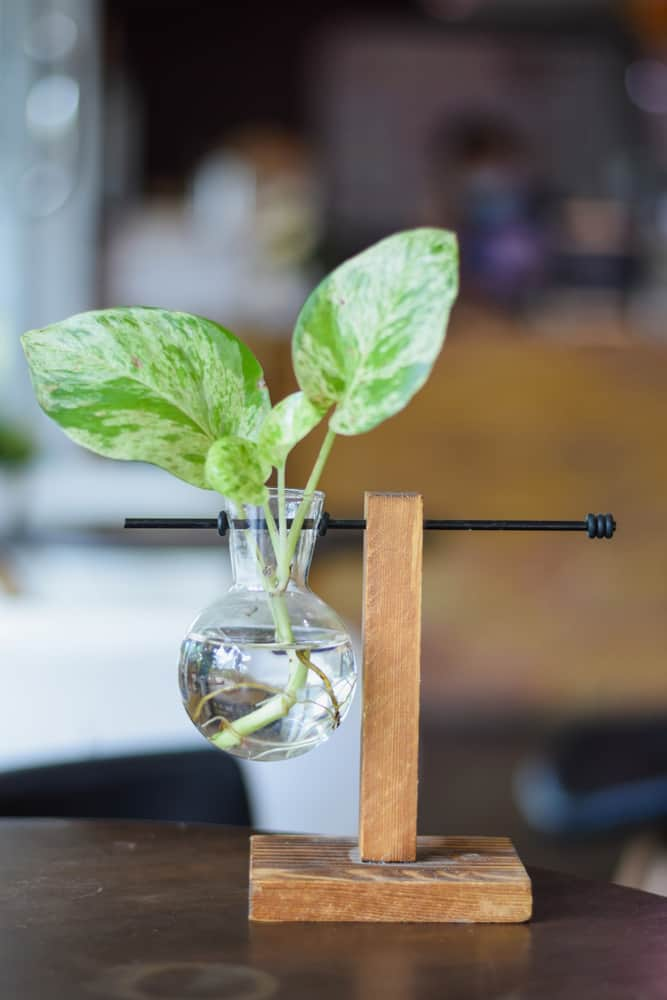
Do you need rooting hormone to propagate pothos?
Together with proper care, rooting hormone can speed up the timeframe it takes for your pothos cutting to grow. That said, it is not a necessity but rather an additional benefit. Rooting hormone can be purchased from nurseries and garden centers, and application is as easy as dipping your stem’s cut end into the powdery substance.
Easy-to-grow plants like pothos don’t generally require rooting hormone and will propagate just fine in water or soil. However, it can be a nice added touch, giving your cutting a little extra boost to set it on its way to developing new roots.
Rooting hormone is easy to get hold of and easy to apply. It’s nice to have a tub on hand before embarking on propagation, and as mentioned, a simple dip of the cut end into the hormone will suffice in terms of application.
What can I use to propagate pothos if I don’t have rooting hormone?
Because rooting hormone is not a prerequisite for rooting pothos cuttings, it’s not necessary to source an alternative if you don’t have this substance on hand. However, many believe that natural options like cinnamon can be just as effective in boosting growth.
Considering that most of us already have cinnamon in our pantries, it’s worth a shot!
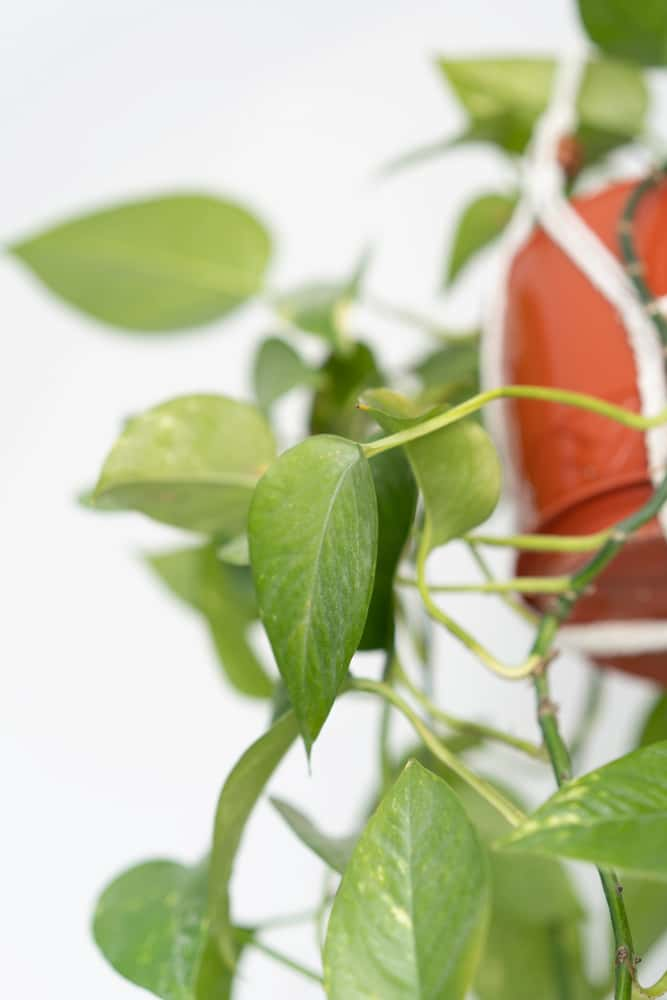
How to propagate pothos without rooting hormone
As rooting hormone is not required for pothos propagation, replacing it with anything else is unnecessary. Pothos can be rooted in water for the best chance of success or directly into soil. In both cases, they should have no trouble thriving with proper care and an ideal growing environment.
Can you propagate pothos from just a stem?
If you have some cuttings from your regular pothos pruning sessions, but they’re devoid of leaves, the good news is that you can propagate pothos from just a stem – if it has visible and viable nodes. They require a slightly different set-up and take longer to root but can take just as successfully as cuttings with leaves.
I hate discarding even the smallest parts of my plants, so I often attempt leafless propagation from stems with visible aerial root nodes. While not as successful as soil or water, propagating pothos stems without leaves can develop new growth with careful care measures.
Can you propagate pothos from a leaf?
Unfortunately, pothos cannot be propagated from a leaf alone, as they require at least a few nodes to develop new roots. Indeed, even a leaf with a small measure of stem and a visible node can take, but without this vital nodule of cells and molecules, there is nowhere for roots to develop from.
As hardy and robust as pothos may be, they do require at least 1 to 2 nodes for roots to develop. This is because, in plant biology, nodes are the collection of cells that turn into roots as they grow and evolve. Without nodes, roots cannot form, and the leaf will eventually perish.
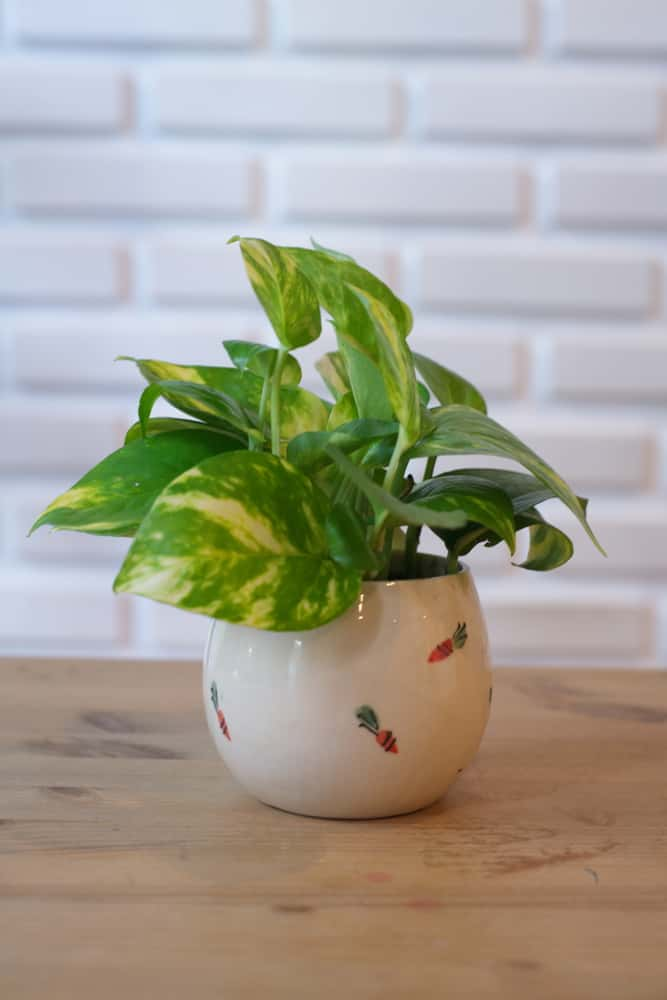
Why isn’t my pothos growing roots?
Environmental factors are the primary reason pothos cuttings don’t always grow roots. In order to develop, cuttings need plenty of light and warmth, hydration, nutrients, and oxygen. If any of these requirements are in a deficit, your cutting may not be able to grow.
Throughout this article, we’ve extensively covered what type of care is needed to root your pothos cuttings successfully, and logic dictates that if any of these needs are not met, your new pothos juvenile will have difficulty growing.
In this regard, keeping an eye on developing cuttings is good, especially if you are rooting in water. If you don’t notice any significant growth in the first two weeks of propagation, it may be time to adjust your growing environment.
How do I make my pothos root faster?
The best way to make your pothos root faster is to give it proper care. Pothos are gratifying and will root with minimal effort. However, they must be set up for success from the get-go, including selecting a robust cutting and their aftercare requirements of hydration, light, and humidity.
Why does my pothos only have one vine?
Pothos tend to grow with only one vine unless you encourage branching through selective pruning. This entails repeatedly cutting your vines above a growth node so that, over time, they’ll develop the urge to branch out with new growth.
Don’t be alarmed if your pothos only has one vine – this is their usual growth habit. Indeed, pothos are known for their long, tangling vines, and will only grow otherwise if trained to do so.
